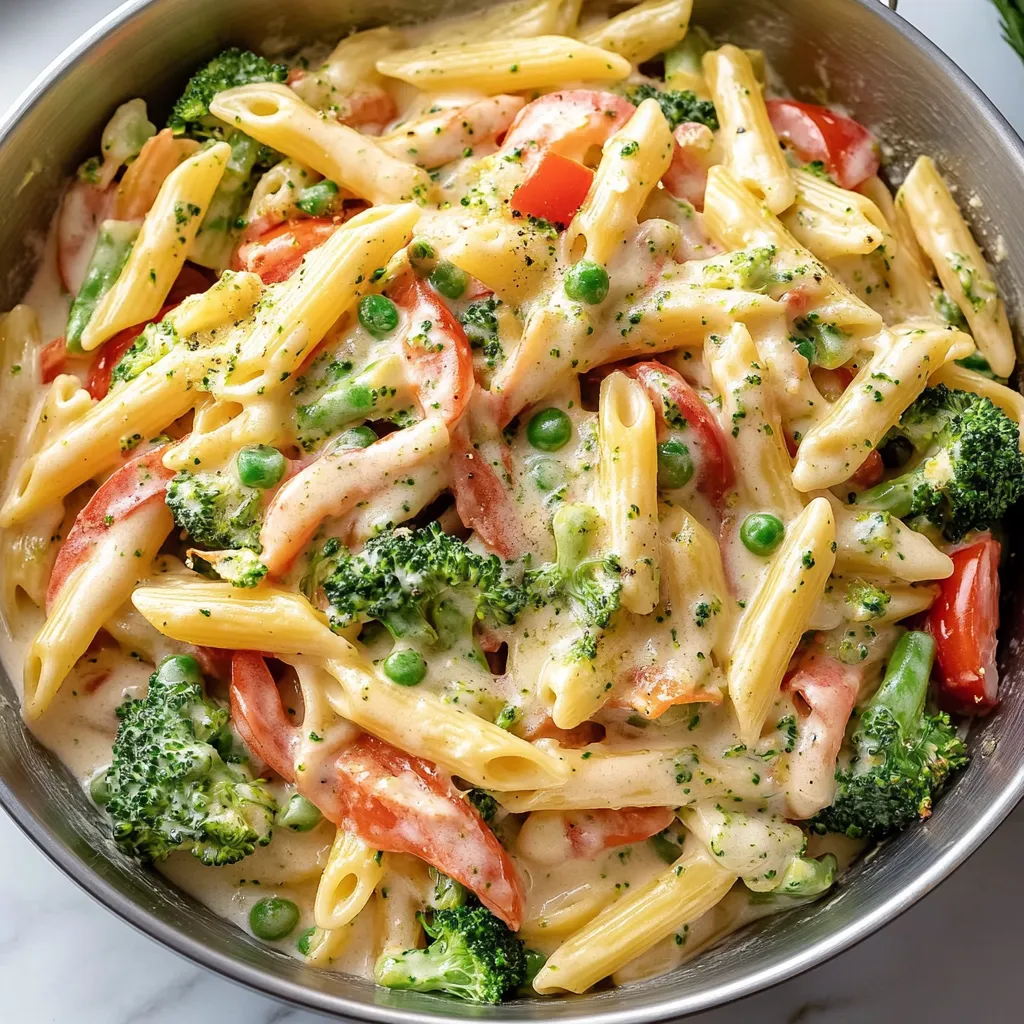 Pin it
Pin it
This hearty pasta primavera has become my go-to recipe when I want to serve restaurant-quality meals at home without spending hours in the kitchen. The herb cream sauce coats every bite of penne and fresh vegetables, making this dish irresistible even to the pickiest eaters in your family.
I first made this pasta primavera during a busy week when I needed to use up vegetables in my refrigerator. My family was so impressed they thought I had ordered takeout from our favorite Italian restaurant. Now it's in our regular dinner rotation.
Ingredients
- Chicken broth: forms the flavorful base of our sauce without making it too heavy
- Half and half: creates the perfect creamy consistency without being as rich as heavy cream
- Dried herbs: add Italian flavors that perfectly complement the fresh vegetables
- Soy sauce and hot sauce: work as flavor enhancers that add depth without making the dish spicy
- Fresh vegetables: bring color, nutrition and texture make this dish pop
- Parmesan cheese: adds rich umami flavor and helps thicken the sauce beautifully
- Lemon juice: brightens all the flavors and cuts through the richness of the cream
Step-by-Step Instructions
- Prepare the Sauce Base:
- Combine chicken broth, half and half, bouillon, soy sauce, hot sauce, and all dried herbs in a measuring cup with a spout. Having this ready makes the cooking process flow smoothly when you need to add liquid to the roux.
- Cook the Vegetables in Batches:
- Heat olive oil in a large skillet over medium-high heat. First add the firmer vegetables like broccoli, onions, carrots and bell peppers for 3 minutes. This gives the denser vegetables a head start on cooking. Next add the quicker-cooking zucchini, peas and tomatoes, seasoning everything with salt and pepper. Cook just 2-3 minutes more to prevent overcooking. Remove all vegetables and set aside.
- Create the Roux:
- In the same skillet over medium heat, melt butter and add garlic, cooking just until fragrant about 30 seconds. Sprinkle in flour and stir continuously for a full 2 minutes. This cooking time is crucial to remove the raw flour taste while creating the thickening base for your sauce.
- Build the Cream Sauce:
- Add the prepared sauce mixture in small splashes while stirring continuously to prevent lumps. Allow the sauce to come to a gentle boil, then reduce heat to a simmer. This gradual approach ensures a silky smooth sauce with no lumps.
- Cook Pasta and Finish Sauce:
- While pasta cooks to al dente, keep sauce partially covered to maintain consistency. Once pasta is drained, reduce heat under sauce to low before adding parmesan cheese in small handfuls, stirring between additions. Finish with fresh lemon juice which brightens all the flavors.
- Combine Components:
- Add drained pasta to the sauce, stirring to coat each piece evenly. Gently fold in the vegetables, allowing them to warm through without overcooking. The entire dish should come together looking colorful and inviting.
 Pin it
Pin it
The secret ingredient that makes this dish special is the combination of soy sauce and hot sauce. It might sound unusual in an Italian-inspired dish, but these ingredients add depth that most restaurant versions miss. My grandmother taught me that good cooking often means breaking a few rules.
Vegetable Variations
This pasta primavera recipe welcomes creativity with your vegetable choices. During spring, consider adding tender asparagus tips or fresh spinach which wilt beautifully into the sauce. Summer gardens produce perfect zucchini, cherry tomatoes, and bell peppers that bring vibrant color. Fall and winter versions can incorporate heartier options like diced butternut squash or Brussels sprouts halves.
The key to success with vegetable substitutions is maintaining similar cooking times. Always add firmer vegetables first, followed by more delicate ones. This prevents some vegetables from becoming mushy while others remain undercooked.
Cheese Considerations
The parmesan cheese plays a crucial role beyond just flavor—it helps create the silky texture that makes this sauce so special. Always grate your cheese fresh from a block rather than using pre-packaged shredded varieties. Pre-packaged cheese contains anti-caking agents that prevent proper melting and can leave your sauce grainy.
For variations, consider substituting half the parmesan with pecorino romano for a sharper flavor profile, or add a few tablespoons of mascarpone for extra creaminess. Remember to always add cheese over low heat to prevent separation and that grainy texture nobody wants.
Serving Suggestions
This pasta primavera stands beautifully on its own as a complete meal, but pairing it with the right accompaniments elevates the dining experience. A simple green salad dressed with lemon vinaigrette provides a refreshing contrast to the rich cream sauce. Garlic bread or focaccia makes excellent vehicles for soaking up any remaining sauce.
For a more substantial meal, consider adding grilled chicken breast sliced over the top or sautéed shrimp folded in just before serving. A glass of crisp Pinot Grigio or Sauvignon Blanc completes the restaurant experience right at your dinner table.
Frequently Asked Questions
- → Can I use a different type of pasta?
Absolutely! You can use penne, farfalle, fusilli, or any pasta you prefer for this dish.
- → How do I make this vegetarian?
Simply swap the chicken broth for vegetable broth, and the dish will be completely vegetarian.
- → Can I add other vegetables?
Yes! Feel free to add veggies like mushrooms, spinach, asparagus, or cauliflower to customize this dish.
- → How should I store leftovers?
Store leftovers in an airtight container in the refrigerator for up to 3 days or freeze for up to 3 months.
- → What’s the best way to reheat this dish?
Reheat in a makeshift double boiler to preserve the creamy consistency or use microwave’s low-power settings.
